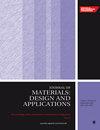用增材制造技术制造的夹芯板常规芯材和分级芯材的平面内和平面外抗压性能
IF 2.5
4区 材料科学
Q3 MATERIALS SCIENCE, MULTIDISCIPLINARY
Proceedings of the Institution of Mechanical Engineers, Part L: Journal of Materials: Design and Applications
Pub Date : 2024-05-21
DOI:10.1177/14644207241255632
引用次数: 0
摘要
由于可以提高轻质部件的强度和能量吸收能力,具有梯度特性的蜂窝材料成为夹芯板的核心材料。蜂窝状的二维蜂窝结构在平面内外受力时具有各向异性。因此,在提出新设计方案时,必须分析蜂窝壁厚度梯度的平面内排列如何影响平面内和平面外的机械性能。这项工作旨在研究分级蜂窝结构与常规六边形蜂窝结构的比较。结构是通过使用铝合金的激光粉末熔床制造的。常规排列的蜂窝具有相同的厚度,而梯度结构的蜂窝厚度具有径向梯度。研究分析了三种创新梯度,即沿同心层径向变化的细胞长度。在平面内和平面外加载时,对规则结构和分级结构的压缩特性进行了评估。通过实验和数值建模对压缩行为进行了评估。尽管数值结果和实验结果不一致,但它们呈现出相同的趋势。与平面内加载测试结果相比,所有分级样品在平面外加载时的机械性能都有所提高,例如刚度值提高了四百倍,吸收能量提高了约三十倍,屈服应力提高了四倍。结果表明,在相对密度相同的情况下,分级样品的强度、刚度和吸收能量值均高于普通六边形蜂窝。本文章由计算机程序翻译,如有差异,请以英文原文为准。
In-plane and out-of-plane compressive properties of regular and graded cellular cores of sandwich panels fabricated by additive manufacturing
Cellular materials with a gradient of properties become appealing as cores of the sandwich panels due to the possibility of improving strength and absorbed energy in lightweight components. 2D cellular structures designated by honeycombs have an anisotropic behaviour when loaded under in- and out-plane. Thus, when proposing new designs, it is essential to analyse how the in-plane arrangement with a gradient in cell wall thickness affects in-plane and out-of-plane mechanical properties. This work aims to study graded cellular structures in comparison with regular hexagonal honeycombs. Structures were manufactured by laser powder bed fusion using an aluminium alloy. Regular arrangements were formed with cells with the same thickness, while graded structures possessed a radial gradient of cell thickness. Three types of innovative gradients, where cell length varies radially along concentric layers, were analysed. The compressive properties of regular and graded structures were evaluated when loaded both under in-plane and out-of-plane conditions. Compression behaviour was assessed, both experimentally and by numerical modelling. Even though there is a mismatch between numerical and experimental results, they exhibit the same trends. All graded samples showed an increased mechanical performance when loaded under out-of-plane conditions in comparison with the results from tests under in-plane loading with values, for example, of stiffness four hundred times larger, absorbed energy around thirty times higher and with yield stress four times larger. The results showed that the graded samples attain higher values of strength, stiffness and absorbed energy in comparison with regular hexagonal honeycombs, for the same relative density.
求助全文
通过发布文献求助,成功后即可免费获取论文全文。
去求助
来源期刊

CiteScore
4.70
自引率
8.30%
发文量
166
审稿时长
3 months
期刊介绍:
The Journal of Materials: Design and Applications covers the usage and design of materials for application in an engineering context. The materials covered include metals, ceramics, and composites, as well as engineering polymers.
"The Journal of Materials Design and Applications is dedicated to publishing papers of the highest quality, in a timely fashion, covering a variety of important areas in materials technology. The Journal''s publishers have a wealth of publishing expertise and ensure that authors are given exemplary service. Every attention is given to publishing the papers as quickly as possible. The Journal has an excellent international reputation, with a corresponding international Editorial Board from a large number of different materials areas and disciplines advising the Editor." Professor Bill Banks - University of Strathclyde, UK
This journal is a member of the Committee on Publication Ethics (COPE).
 求助内容:
求助内容: 应助结果提醒方式:
应助结果提醒方式:


